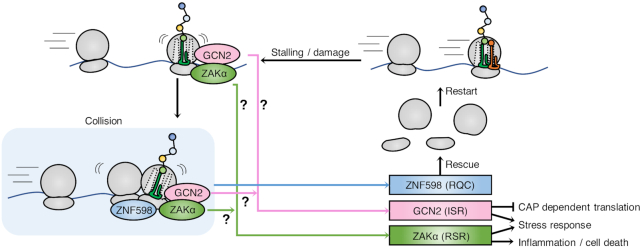Figure 5.
Sensing mechanisms and outcomes of ribosomal stress-surveillance pathways. Local translational arrest leads to collision of ribosomes, which is a signal for recruitment and activation of the RQC pathway sensor ZNF598. The RSR sensor ZAKα and the ISR sensor GCN2 may also be activated by recognition of this structure, or alternatively by sensing signals directly on stalled ribosomes. Once activated, the RQC pathway will attempt to rescue and recycle stalled ribosomes. The ISR pathway activates stress responses by inhibiting cap-dependent translation and facilitating selective translation of stress response proteins. The RSR pathway activates MAP kinase-driven stress responses and inflammatory signaling and may also mediate apoptotic signaling.

